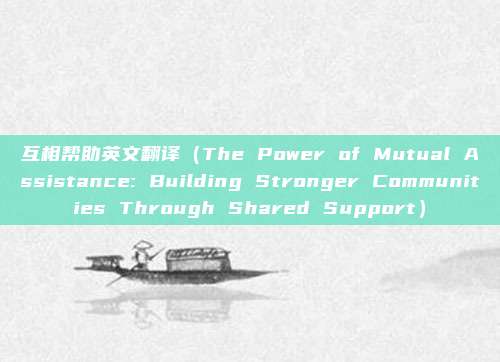互相帮助英文翻译(The Power of Mutual Assistance: Building Stronger Communities Through Shared Support)
温馨提示:这篇文章已超过296天没有更新,请注意相关的内容是否还可用!
In the tapestry of human civilization, the thread of mutual assistance has woven together the stories of countless communities. It is a fundamental aspect of our existence, a driving force behind the progress and unity of societies around the world. The concept of "互相帮助" (mutual assistance) is not just a linguistic term; it is a universal principle that transcends cultures, languages, and borders. This article delves into the significance of mutual assistance, its impact on communities, and how it fosters a sense of belonging and resilience.
The Essence of Mutual Assistance
At its core, mutual assistance is the act of providing support, help, or guidance to others in need. It is an expression of empathy, compassion, and solidarity. Whether it's offering a helping hand in times of crisis or sharing knowledge and resources for the betterment of all, mutual assistance is a cornerstone of human interaction.
Building Stronger Communities

Communities that thrive on mutual assistance are often characterized by higher levels of trust, cooperation, and social cohesion. When individuals come together to support one another, it creates a ripple effect that strengthens the fabric of the community as a whole.
1、Enhanced Social Bonds: Mutual assistance fosters a sense of togetherness and belonging. When people help each other, it reinforces the bonds of friendship and camaraderie, making the community more resilient to external pressures.
2、Shared Resources: By pooling their resources, communities can address common challenges more effectively. Whether it's organizing community events, sharing educational opportunities, or collaborating on local projects, mutual assistance ensures that everyone has access to the tools they need to succeed.
3、Empowerment: When individuals feel supported by their community, they are more likely to take on leadership roles and contribute to the collective good. Mutual assistance empowers people to become active participants in shaping their own destiny.
Real-World Examples
From the small villages in Africa to the bustling cities in Asia, mutual assistance is evident in countless ways:
Microfinance: In rural areas, microfinance initiatives enable individuals to start their own businesses with small loans and mentorship from community members.
Volunteer Programs: In urban centers, volunteer organizations provide essential services such as food banks, tutoring, and shelter to those in need.
Crisis Management: During natural disasters, neighbors and local organizations often come together to provide relief and support to affected communities.
Challenges and Solutions
While mutual assistance is a powerful force, it is not without its challenges. Inequality, lack of trust, and competition for resources can hinder the effectiveness of community support. To overcome these challenges, here are a few solutions:
1、Education and Awareness: Promoting the importance of mutual assistance through education can help foster a culture of giving and receiving within communities.
2、Inclusive Leadership: Ensuring that leadership positions are diverse and representative of the community can help build trust and inclusivity.
3、Collaborative Decision-Making: Encouraging community members to participate in decision-making processes can help ensure that the needs of everyone are met.
Conclusion
The concept of mutual assistance is a testament to the human spirit's capacity for kindness, cooperation, and resilience. By embracing the principle of "互相帮助," we can create stronger, more vibrant communities that are better equipped to face the challenges of the future. Whether through small acts of kindness or large-scale initiatives, mutual assistance is a powerful force that has the potential to transform the world for the better.
网站文章、图片来源于网络,以不营利的目的分享经验知识,版权归原作者所有。如有侵权请联系删除!





还没有评论,来说两句吧...